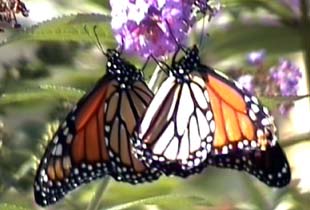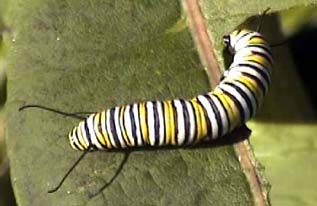 Monarch
Butterflies
Monarch
Butterflies Monarch
Butterflies
Monarch
Butterflies
The milkweed plants (Asclepias syrica) in the habitat garden had several visitors over the summer. My daughter Jenny, who helped care for the garden over the summer, discovered two colorful caterpillars munching away in August.

Did you know that the milkweed plant's white "milk" contains a low toxicity poison. By eating these plants, the caterpillar and the butterfly have this poison, as well. This makes them "yuchy" to predators. Very clever!
 |
In September, several students found a chrysalis under the plants during recess. We observed that the chrysalis was about an inch long. It was a beautiful green that was very close to the color of the milkweed leaves. I wonder why? The golden dots appeared to glisten just like real gold. It was beautiful to behold! |
|
|
Mrs. Graham's fourth grade observed the chrysalis until the butterfly emerged. They saw the butterfly forming through the seemingly transparent chrysalis. When the butterfly emerged, it was released into the habitat garden. We wish it a speedy and safe journey to Mexico for the winter. Butterfly life cycle http://www.monarchwatch.org/biology/cycle1.htm
|
|
|
Invite monarchs to your school. In the fall, look along the roadsides for the familiar pods of the milkweed plants. When they pop open they release many seeds which are carried on the wind to new ground via their puffy, white fluff. Harvest a few seeds. Clear an open patch of soil in a sunny spot by your school. Plant the seeds in the fall. Put a label on the plot of land so that helpful folks don't weed it for you. Keep an eye out in the late spring for the plants to emerge. Don't give them much care. They are hardy, wild plants. They are not use to much fussing. Be sure that no one sprays chemicals near the milkweed patch. Over the summer, the plants will grow about three feet high and have broad, flat leaves. Their beautiful pink flowers attract the monarch butterflies. Observe the plants occasionally for visitors. Look for the caterpillars on the underside of the leaves. You might find evidence of chewed leaves even if you don't see the caterpillar. (Native Americans used the tough inside fibers of this plant to make rope and fishing nets! They also used it as a medicine.) Indian Herbalogy of North America by Alma R. Hutchens Milkweed coloring page link http://www.nps.gov/plants/color/northwest/4.htm |
Monarch Butterfly Mania
Cindy O'Hora, Conestoga Elementary's parent habitat volunteer, created a monarch showcase. It showed the stages of development, maps of migration routes, and how to tell a male monarch from a female. The highlight was a milkweed plant that had an egg on it. The egg hatched. The caterpillar ate the plant. It crawled to the top of the showcase and became a pupa. Finally, we returned after a weekend to discover a beautiful butterfly in the showcase. We sent it on its way to Mexico with a cheery "Adios!"
Visit Milkweed and Monarch Butterfly Mania to lean about these beautiful invertebrates and the plant they need to survive.
Journeying south
Mrs. Graham's fourth grades are participating in a project that mimics the monarch's migration south. The students created paper monarch butterflies. They put messages in Spanish on them with the help of Mrs Cheryl Youtz (spanish teacher) and her students. The paper monarchs where sent to a central site which forwards them to students in Mexico. 10/98
5/99 - It is so excting! The paper monarchs have returned to our classroom! A set has arrived from Mexico with messages to our students.
Muchas Graçias to Mrs. Youtz & her students for translating them for us!From the More About Your Butterfly's Journey press release
"The Journey North office will become a migration staging area for paper butterflies this fall. In late October, the butterflies will be packaged into large boxes and carried to Mexico. They will be on display all winter at the Papalote, Museo del Nino, where hundreds of children will see them every day. When the real monarchs leave Mexico in the spring, our friends at Papalote will return the butterflies to the Journey North office. There they will be put into the envelopes you and other classrooms provided for their return trip. Sometime next spring, your envelope will arrive and-- if all goes well-- inside you'll find the same number of butterflies you sent to Mexico. But these butterflies won't be your own. The butterflies you receive next spring will tell their own stories as you discover who made them, who cared for them during the winter, and where they have traveled."
For more information on this project please visit Journey North's WWW site at: www.learner.org/jnorth
Butterfly links
|
|
Butterfly garden site http://butterflywebsite.com/resource/index.cfm Monarch Watch - offers a multitude of monarch resources for all ages. USGS's Biological Resources Division Northern Prairie Wildlife Research Center at Jamestown, North Dakota. Hundreds of insect collectors, scientists, museums, and photographers have contributed to this popular web site. |